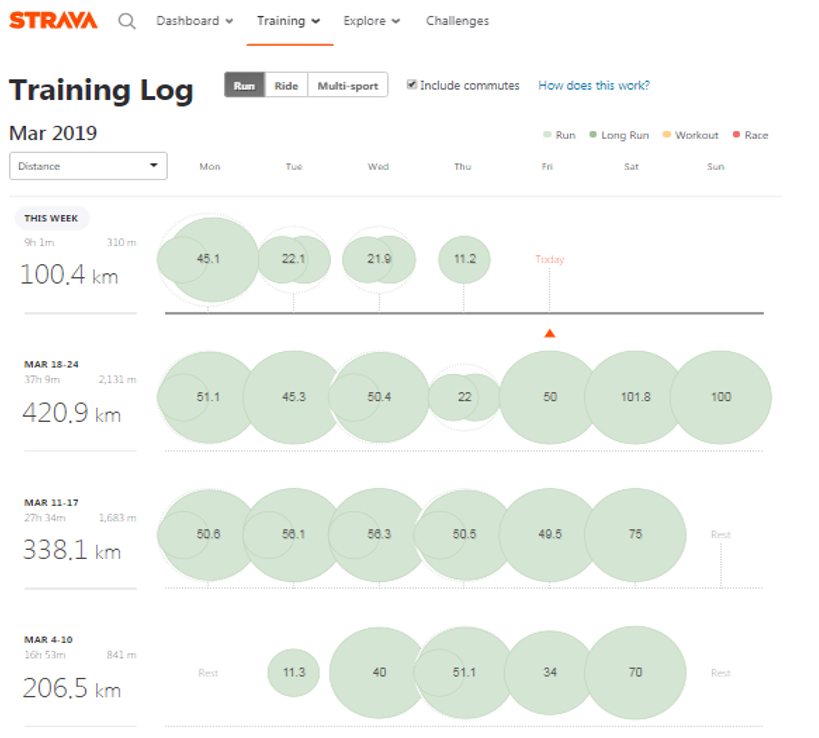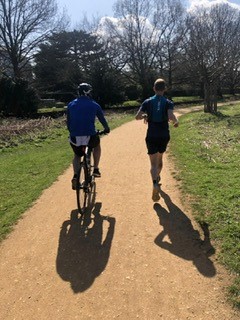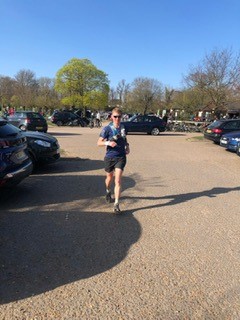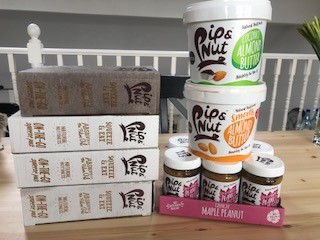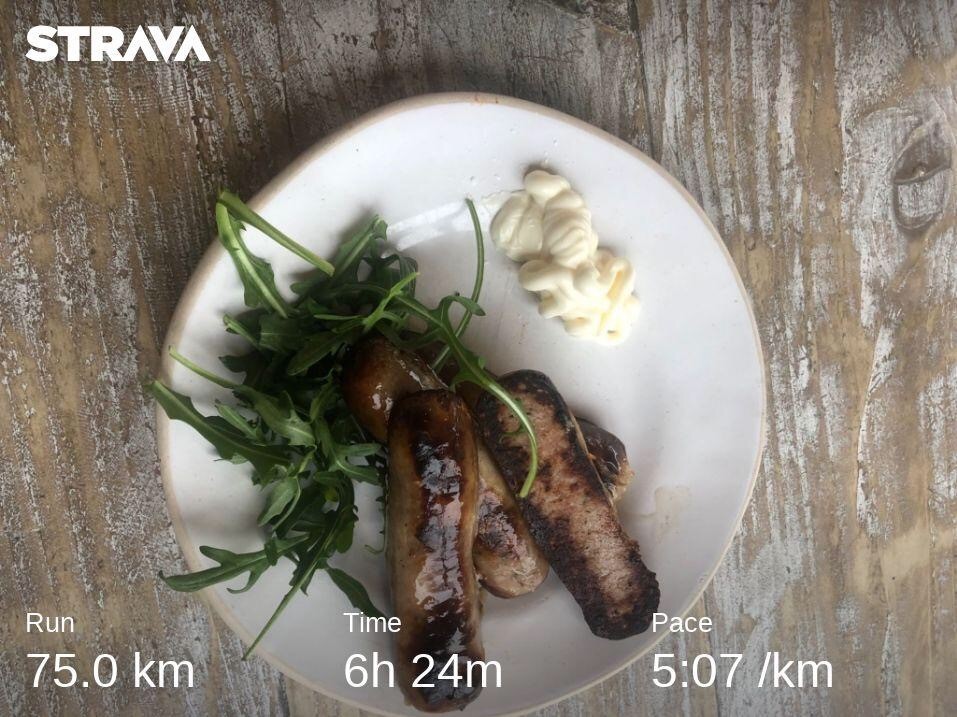What is the Monthly Mileage?
The monthly mileage is a series which gives you an insight into my training and preparation for my world record attempt in May 2019 to run more than 800 miles in 9 days.
It includes an overview of my running and nutrition stats for the month.
Plus, there are tips that will help you achieve your goals.
March was another big month of running.
But I also did a huge amount of organisation for my world record attempt.
So this month I’m giving you 4 tips for how to prepare for major events, such as races and long training runs.
As a teaser, here’s a video of how I prepared the night before doing back-to-back runs of 100km each day.
How do I prepare the night before a major run? This routine means I can get up at 4am and get out the door quickly!
Plus, I’m even giving you a FREE pre-race checklist.
I personally use the checklist to prepare for races. Which included my win at the Autumn 100 mile event.
All you have to do is sign up with your email, below.
AND, by signing up, you’ll get a FREE training plan template.
The template will save you time, money and effort when creating your own plans.
Finally, as an email subscriber, you’ll also get an exclusive summary of the best training and racing articles that I’ve read.
Simply sign up using the button below to get all of that great content!
What Were My Running Highlights for March?
In March, I ran a total of 1,066km (662 miles).
The month started off in the same way as February finished…
… With several days of not running, because I was on a family holiday in America.
You can read February’s blog here, and get 4 tips on how to use rest to improve your performance.
March was my second biggest month of running ever, with 1,066 km (662 miles)
But the rest of the month ramped up quickly.
My highlights included:
Huge Training Weeks and Individual Runs
I ran my biggest ever week of 421km (262 miles).
That included back-to-back runs of 102km on Saturday and 100km on Sunday.
I also ran 338km (210 miles) in the week before that.
March included my biggest ever week of running - 421km (262 miles). Where I did back-to-back training runs of 100km each
And despite this huge month, I’m still not top of the Strava monthly leader board for most distance run in a month…
… I have too many rest days to challenge for that title :-)
The Second Long Training Weekend
My training plan means that I will have three big weekends before my world record attempt in May.
These are opportunities for me and my crew to get together and practise as if it’s the actual challenge.
The first one was in January. A month where I ran more than 1,200km. You can read about that here.
And in March, it was time to do it again…
This time with a 102km run on the Saturday…
… And then 100km on Sunday.
The weekend was incredibly successful.
And that was mostly due to the incredible support I had.
First, from my wife, Catherine.
She prepared a huge amount of food for me.
This included the low carb almond butter smoothie, which has been a secret weapon for me in my race wins and training runs.
She also made macadamia ‘fat bombs’ and an almost endless supply of sausages.
And she even found time to write me a motivational note for when I came back after the first day.
Without Catherine’s incredible dedication and support, I would never have got this far.
Catherine (my wife), Rosie and Lottie (my daughters) left me a motivational note to read after my first long day of 100km
The weekend was also a success due to my fantastic crew of Ben Cooper, Jack Donaldson and Jamie Riddett.
They were there to give me psychological support when I was feeling a bit down, water when I was thirsty and food when I was hungry…
Including baby food when I couldn’t handle proper food anymore!
Getting Organised
I’m now 8 weeks away from starting my 9 day, 800 mile journey from Land’s End to John o’ Groats.
And so the planning is really ramping up.
I made excellent progress in confirming the two motor homes and bikes that are going to support my attempt.
Plus the crew and I created some very extensive checklists.
Great fun!
These were for the jobs that they are going to have to do on a daily basis, including food prep, driving, shopping, cleaning, organising my kit, biking and numerous other jobs.
The team and I had a very successful meeting to discuss preparation for my LEJGO attempt.
Everyone loves a checklist and an excel spreadsheet!
And with all of that combined, my key running stats were:
1,066km (662 miles) - Total distance ran
34km (21 miles) - Average distance ran per day
102km (63 miles) - Longest individual run. Followed by a 100km run the next day. And a 45km run the day after
90 hours, 37 minutes - Total time spent running
4,965 metres (16,300 feet) - Total elevation. The equivalent of climbing the highest mountain in Venezuela, Pico Bolivar.
You can track my training by following me on Facebook, Twitter, Instagram and Strava.
How Much Crap Did I Eat in March?
As I was relaxing in America for the first few days, my eating habits were very poor.
But after that I was much better sticking to my low-carb, high fat diet.
Food during my long runs included:
Pip & Nut nut butter sachets - My followers can now get an exclusive deal with Pip & Nut of 15% off. Just use promo code JW15 at the checkout
Almond Butter Smoothie - Which I use before and during long runs
Sardine and microwaved eggs - This is my standard breakfast
Baby food - Something which you can get down easily when your stomach isn’t feeling great
Sausages - During one of my runs, I had a stop in a cafe and picked up some sausages. And covered them in mayonnaise. Because this was such a success, I’ve used them on my long training runs
Other non-running food highlights included
Egg and bacon wrapped in romaine lettuce
Salmon, bacon, eggs and avocado
Salmon and tuna poke bowl
But, as with anything, it’s important to have balance in your life.
Pancake day with the family was one of those days…
And I rewarded myself after a 202k running weekend with a sticky toffee danish… And a Chinese takeaway… And a cheesecake!
March’s Top Tips - 4 Simple Steps to Prepare Properly for Races
1) Do Your Research
The race website should have a huge amount of information that will help you start your training and race well.
At the most basic level, you should find out:
Where and when you have to be before, during and after the race
Cut-off times
What nutrition is handed out at aid stations? And how often is it handed out?
Course profile
Mandatory things - Like kit or a race briefing
This may sound like simple information that nobody would ignore.
But many people get this part very wrong.
Including me…
As part of training for my first every Ironman race, I used PowerBar bars for the bike and the run.
But I hadn’t done my proper research…
And I didn’t realise was that during the race itself, they only handed out gels on the run.
So, the first time that I had ever had a gel was nine hours into the race itself.
It was one of the worst digestive experiences of my life. And I ended up on the porta-toilets for a large amount of time during that race!
So, if you don’t want a story for your grand-kids that involves shitting yourself, do your research!
Another really good way of getting this information is to ask other people.
Ideally, you would ask someone who has done the actual race before.
And if you don’t know anyone, then simply Googling ‘race review for [race name]’ or something similar, will be very helpful.
“This is where coaches can offer the most valuable advice. Because they have seen it and done it before.”
If you’d like to find out more about the coaching services that I offer for runners and triathletes, then find out more on my coaching page.
A coach should help you with your research. And the research should mean that they create very specific plans for you and your goals.
If they don’t, then they may not be helping you as much as they should.
Doing your research is a vital first step, because it will feed into the next two points.
2) Define Your Race Strategy
You should start thinking about your race strategy even before you sign up to a race.
For example, if you’re signing up to a 100 mile event for the first time, is your goal just to complete it? Or do you want to get onto your country’s national team?
These two very different objectives would mean very different strategies for pacing, nutrition, kit preparation and other elements.
Here are some basic things to think about when defining a race strategy:
Pacing
What pace will you need to average in the race to achieve your goal?
This will form the baseline for your training. Because you should be doing sessions which will mean you can achieve the race pace on the day itself.
That doesn’t mean that all sessions will be done at that pace though. Some sessions will be much harder, whilst a lot will be easier.
Nutrition
What will you need to eat?
And when will you eat it?
The research you’ve done on the race itself will play a big part in this. Will you be able to rely on aid stations? Or will you need to carry more food and drink, because you can’t rely on aid stations?
Again, your strategy will have a big influence on your training. Because you need to practise it specifically in training. So that nothing is unfamiliar on race day
3) Create An Itinerary and Checklists
Whilst you could would argue that the first two points are necessary for everyone, this one is for the more detail-minded people (like me!).
Checklists have been proven to improve performance in a number of industries - Note, one of the first uses was in the airline industry to reduce crashes.
But they are widely used in the medical industry to reduce mistakes too.
“(Checklists) not only offer the possibility of verification but also instil a kind of discipline of higher performance”
Checklists are very effective at…
Reducing mistakes - For example, forgetting that piece of kit. Or forgetting what time you need to be at a race briefing
Settling nerves
Giving you less to think about in the build up to the race.
You can even grab your FREE pre-race checklist.
I personally use the checklist to prepare for races. Including my win at the Autumn 100 mile event.
Simply sign up using the button below.
4) Visualise
The mental aspect of racing is something that can make the difference between a great performance and a bad one.
And you should be practising this just like you would practise anything else in your training - Pacing, nutrition and rest.
“Visualisation is just one of several mental skills that can have a direct and positive impact on performance…in any sport”
This article by Running.com outlines three different forms of visualisation:
Internal - Done in first person; here the athlete runs through the race in their mind as they would see it from their own perspective
External - Done in the third person; picturing yourself as an outside observer watching you run the race
Kinesthetic - Integrating bodily movements and muscle sensations with the mental pictures. This style has been proven to be of the greatest benefit to athletes if they are able to fully tap into the experience
I’ve found visualisation hugely beneficial. Although it was awkward at first.
Luckily, I’ve found an extremely skilled sports psychologist, Evie Serventi, to help me with it.
I now call on a library of situations, both positive and negative, that help me when preparing for a challenge.
And they can be used in the challenge itself.
One method is to visualise times in the past where I’ve had success.
I’ve created imagery based on the sights, sounds, smells and feelings that I had as part of my Autumn 100 mile race win.
Another method is to create imagery for something in the future.
One example is how I am working on building imagery based on the finish of my challenge to run from Land’s End to John o’ Groats.
I’ve never been to John o’ Groats before.
But I can imagine my wife and two daughters being at the signpost as I finish. As well as other family members, and, of course, my support crew.
You can use this technique effectively for races as you can imagine yourself crossing the finish line.
Or visualise the key moments before or during the race.
For example, you can imagine yourself going through your pre-race routine. Which can help settle nerves and spot things that you might have forgotten.
For more information on how to use visualisation, and many other mental techniques, to improve your performance contact Evie Serventi.
How Did Your Training Go in March?
Let me know in the comments at the bottom of this blog, on the Contact Page or on social media below.
What’s Coming Up in April?
There’s less than 8 weeks to go until I start my run from Land’s End to John o’ Groats!
There’s less than 8 weeks to go until my world record LEJOG attempt in May 2019 - It starts on Saturday May 25th
I just wish it was only 747 miles!
And so I’m into the final major push for training.
One of the key points in April will be another major training weekend on Saturday 13th and Sunday 14th.
I’m aiming to run between 130 - 145km (80 - 90 miles) on each day.
You can follow my training on Strava and on social media.
Save Time, Money and Effort by Claiming Your Free Training Plan Template
Join hundreds of other athletes who get amazing benefits, simply by providing your email.
A FREE training plan template - Which will save you time, money and effort when creating your plans
The best training and racing advice from across the web - I send these articles out every month, exclusively, to email subscribers
Early access to exclusive offers and deals - I send out the best discounts and offers to email subscribers first, before anyone else
What Did You Think Of This Article?
I would love to get your honest feedback about what you think about the articles on JamesRunsFar.com.
I can use your feedback to write blogs that what will help you achieve your goals.
Simply tell me what you think by filling in this 1 minute survey.
What Should You Read Next?
Find out how I could Help You Improve Your Performance through coaching
Improve your performance with my personally recommended Kit, Nutrition and Gadgets
How did I prepare for the Autumn 100 mile race, where I came in 1st place?! - Including a FREE pre-race checklist!



